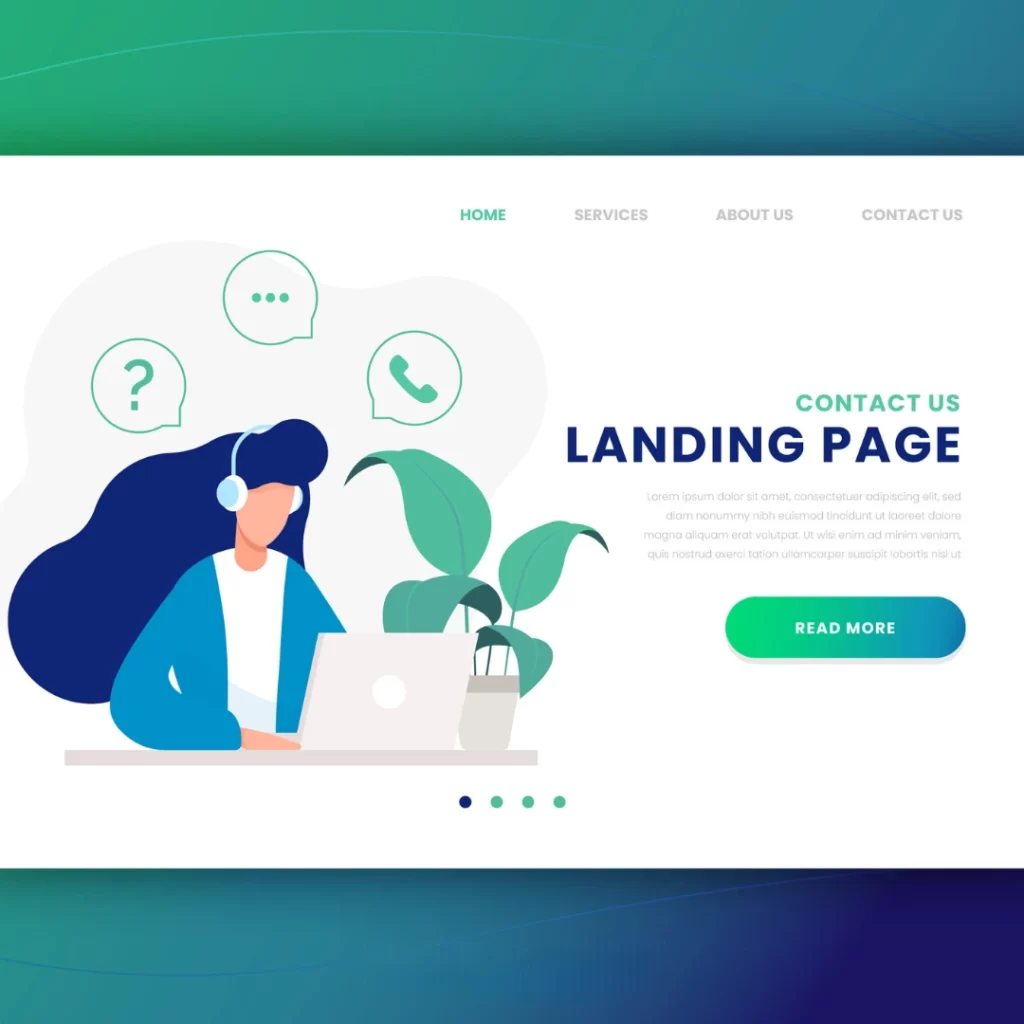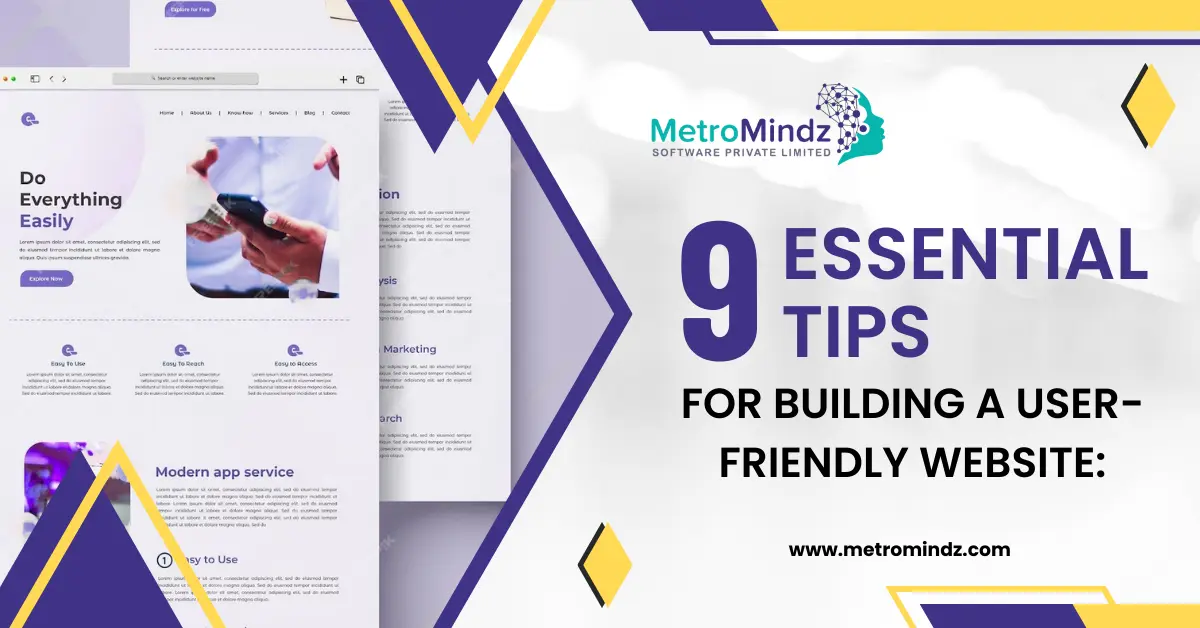
Creating a user-friendly website is crucial in today’s digital landscape. Your website serves as the digital face of your brand, and a positive user experience can significantly impact your success. In this informative blog post, we will explore nine essential tips that every website owner should consider when building or optimizing their site. From intuitive navigation to mobile responsiveness, we’ll cover key elements to ensure your website not only attracts visitors but also keeps them engaged and satisfied. Join us as we delve into the world of user-friendly web design and discover how these practical tips can elevate your online presence.
Importance of Clear and Organized Menus
Navigation menus play a crucial role in the User Experience of a website. It provides a proper guide for our visitors to get from the home page to the interested page. It improves the user experience from the search engine’s point of view and from the point of view of SEO. It provides a professional look to the website
Implementing a user-friendly breadcrumbs
The Breadcrumbs help users was easy to go to their particular product or service pages. they help the user identify the current position of the website pages. It tells to user and search engine bot the hierarchy of the page inside the website. There are three types of breadcrumbs mainly used in website design.
1. Pathway Breadcrumbs
2. Hierarchy breadcrumbs
3. prodcut or Servies-based Bredcurmbs
mobile responsiveness, we’ll cover key elements to ensure your website not only attracts visitors but also keeps them engaged and satisfied. Join us as we delve into the world of user-friendly web design and discover how these practical tips can elevate your online presence.
Utilizing a logical page hierarchy
In the digital age, organizing your website’s content with a well-thought-out logical page hierarchy is crucial. By structuring your pages logically, you enhance user experience, improve SEO rankings, and make navigation a breeze. Start with a clear homepage, followed by categorized sections and subpages. This intuitive structure ensures that visitors find what they need effortlessly, keeping them engaged and satisfied. In this article, we’ll explore the benefits of a logical page hierarchy and provide practical tips for implementing it effectively on your website.
Responsive Design:
Significance of mobile-friendly layouts:

In today’s mobile-driven world, having a mobile-friendly website layout is not just an option but a necessity. Mobile users make up a significant portion of online traffic, and an adaptable design ensures seamless accessibility and optimal user experience across various devices. Mobile-friendliness directly impacts SEO rankings, visitor engagement, and conversion rates. This article delves into the compelling reasons why mobile-friendly layouts are essential for your website’s success, offering insights and strategies to create a responsive design that caters to your mobile audience effectively.
Using responsive frameworks and tools
Creating a website that adapts flawlessly to diverse devices is no longer optional but imperative. Responsive frameworks and tools play a pivotal role in achieving this goal. In this comprehensive guide, we explore the world of responsive web design, highlighting the significance of frameworks and tools. Discover how these resources streamline development, ensure cross-device compatibility, and enhance user experience. Whether you’re a seasoned designer or a novice, this article equips you with the knowledge needed to create stunning and responsive websites.

Testing across various devices and screen sizes
To succeed in today’s digital landscape, rigorous testing across various devices and screen sizes is paramount. This article dives deep into the crucial practice of cross-device testing, showcasing its pivotal role in ensuring optimal user experiences. Learn the importance of testing methodologies, responsive design validation, and how to address common challenges. With insights and practical tips, this guide empowers you to confidently deliver websites that shine on every screen, leaving no user behind.
Fast Loading Speed:
Optimizing image and multimedia content

In the digital realm, content optimization is king, and a pivotal aspect is enhancing image and multimedia assets. This article delves into the art of optimizing these content types for peak performance. Discover the magic of image compression, format selection, and multimedia encoding techniques that reduce load times while maintaining quality. We’ll also explore the importance of responsive design and accessibility considerations. With these insights, you’ll empower your website to deliver a superior user experience and excel in today’s competitive online landscape.
Minimizing HTTP requests
minimizing HTTP requests is crucial for optimizing website performance. Reducing HTTP requests plays a critical role in optimizing website performance. By reducing the number of requests, loading times decrease, enhancing user experience. To achieve this, consolidate CSS and JavaScript files, utilize image sprites, and employ asynchronous loading. Additionally, leverage browser caching and content delivery networks (CDNs) to further streamline HTTP requests, ultimately ensuring a faster and more efficient web browsing experience.
Leveraging browser caching and content compression
Leveraging browser caching and content compression are essential techniques for improving website speed and performance. Browser caching stores frequently accessed files locally, reducing server requests and load times. Content compression, such as GZIP, minimizes file sizes for faster downloads. Together, these practices enhance user experience by delivering web content swiftly and efficiently, resulting in lower bounce rates and improved SEO rankings.
Readable Typography:
Choosing web-safe and readable fonts

Selecting web-safe and readable fonts is crucial for effective web design. Web-safe fonts ensure consistent display across various browsers and devices. Prioritize readability by choosing fonts with clean, legible styles. Sans-serif fonts like Arial and Helvetica are popular choices for online content due to their clarity. Maintain a balanced font size and spacing to enhance user experience and accessibility, ensuring that your website’s text remains easily readable for all visitors.
Proper font size and line spacing for readability
Proper font size and line spacing play a vital role in enhancing text readability on websites. Optimal font size ensures content is easy to read without straining the eyes. Line spacing, or leading, provides visual separation between lines, reducing clutter and improving comprehension. For most web content, a font size of 16-18 pixels and a line spacing of 1.5 times the font size offer a balance between aesthetics and readability, catering to a broader audience.
Contrast between text and background
The contrast between text and background is critical for readability and accessibility in web design. High contrast enhances legibility, making content easier to read for all users, including those with visual impairments. Dark text on a light background or vice versa is a common choice. Ensure sufficient contrast ratios, typically 4.5:1 for standard text. Effective contrast not only improves readability but also contributes to a better user experience and compliance with accessibility standards.
Clear Call-to-Actions (CTAs):
Strategically placing CTAs for desired actions

Strategically placing CTAs (Call to Actions) is crucial for driving desired user actions on a website. Position CTAs prominently where they align with user intent, such as ‘Buy Now’ buttons near product descriptions. Utilize contrasting colours to ensure they catch the eye effectively. Employ compelling and action-oriented text to encourage clicks. A/B testing can help optimize CTA placement for improved conversions, ensuring visitors take the desired actions, whether it’s making a purchase, signing up, or subscribing.
Enhance CTA visibility with the strategic use of contrasting colours
Using contrasting colours effectively highlights CTAs (Call to Action) on a webpage. High-contrast combinations, like a bold colour against a neutral background, draw immediate attention. This visual distinction prompts users to take action, whether it’s making a purchase, subscribing, or signing up. Maintain consistency with your brand colours while ensuring that the CTA colour stands out noticeably, enhancing user engagement and conversion rates.
Crafting compelling and concise CTA copy
Crafting compelling and concise CTA (Call to Action) copy is essential for driving user engagement. Use action-oriented words like ‘Get Started,’ ‘Join Now,’ or ‘Shop Today’ to prompt immediate response. Keep the text concise, focusing on the benefits users will receive. Emphasize urgency or exclusivity when applicable, instilling a sense of importance. Effective CTA copy encourages user action, leading to higher conversion rates and achieving your website’s objectives.
Simplified Forms:
Minimizing form fields for user convenience
Minimizing form fields enhances user convenience during website interactions. Shorter forms reduce friction, increasing the likelihood of user completion. Prioritize essential information and remove unnecessary fields. Implement auto-fill and clear instructions to simplify the process. By streamlining forms, you improve the user experience, boost conversions, and encourage users to engage more readily with your website or services, resulting in a positive overall impression.
Providing inline validation and error messages
Inline validation and error messages are vital for user-friendly web forms. As users input data, real-time validation feedback ensures accuracy. Clearly communicate errors with descriptive messages, pinpointing issues and suggesting corrections. This approach minimizes frustration, helps users correct mistakes promptly, and encourages successful form submissions. By implementing inline validation and clear error messages, you enhance user satisfaction and reduce abandonment rates on your website’s forms.
Offering guest checkout and autofill options
Providing guest checkout and autofill options simplifies the online shopping experience. Guest checkout allows users to complete purchases without creating accounts, reducing friction. Autofill streamlines data entry by suggesting or automatically populating fields with saved information. These features save time and improve user convenience, ultimately boosting conversion rates. By offering these options, businesses can enhance user satisfaction and encourage more seamless transactions on their websites.
Visual Consistency:
Establishing a cohesive colour scheme and branding

Establishing a cohesive color scheme and branding is vital for a strong online presence. Consistency in color choices across your website and marketing materials fosters recognition and trust. Carefully select colors that align with your brand’s identity and evoke desired emotions. Create a style guide to maintain uniformity. A cohesive color scheme and branding enhance brand recognition, user experience, and overall brand integrity, making your business more memorable and credible.
Maintaining consistent design elements across pages
Maintaining consistent design elements across web pages is fundamental for a seamless user experience. Consistency in layout, navigation, fonts, and color schemes enhances user familiarity and usability. It reduces confusion, making it easier for visitors to navigate your site. Utilize design templates and adhere to established guidelines to ensure continuity. Consistent design elements build brand recognition and trust, resulting in a cohesive and user-friendly website that encourages engagement and conversions.
Using whitespace to enhance visual appeal
Whitespace, also known as negative space, is a powerful design element that enhances visual appeal. It provides breathing room around content, improving readability and aesthetics. Properly utilized whitespace can draw attention to key elements, such as text or images. It reduces clutter and creates a sense of balance and sophistication. When incorporated effectively, whitespace enhances the overall user experience, making your website more engaging and visually pleasing.
Accessible Design:
Ensuring compatibility with screen readers and assistive technology
Ensuring compatibility with screen readers and assistive technology is vital for web accessibility. Incorporate alt text for images, use semantic HTML, and provide text equivalents for multimedia. Test your site with screen readers to ensure content is easily navigable. By making your website accessible, you cater to a broader audience, including individuals with disabilities, enhancing inclusivity and complying with legal requirements, such as the Americans with Disabilities Act (ADA).
Incorporate Alt Text for Images and Captions for Videos
Adding alt text to images and captions to videos improves web accessibility. Alt text provides descriptions for images, aiding users with visual impairments. Captions on videos benefit those who are deaf or hard of hearing. Use descriptive and concise alt text, and ensure captions accurately convey audio content. These practices enhance inclusivity, comply with accessibility standards like WCAG, and make your web content more accessible and engaging for a diverse audience.
Providing keyboard navigation options
Offering keyboard navigation options is essential for web accessibility. Implement keyboard shortcuts and focus styles to enable users to navigate your site without a mouse. Ensure all interactive elements are reachable and operable via keyboard commands. This inclusive design approach accommodates individuals with motor disabilities and ensures compliance with accessibility standards like WCAG, making your website usable and user-friendly for a broader audience.
Search Functionality:
Including a prominent and functional search bar
Facilitating keyboard navigation, along with a prominent and functional search bar, enhances user experience. Ensure your website is fully accessible via keyboard commands, allowing users to navigate without a mouse. A well-placed and efficient search bar aids in finding content quickly, improving user satisfaction. This combination of keyboard navigation and a user-friendly search feature ensures ease of use for all visitors, including those with disabilities, promoting inclusivity and usability.






